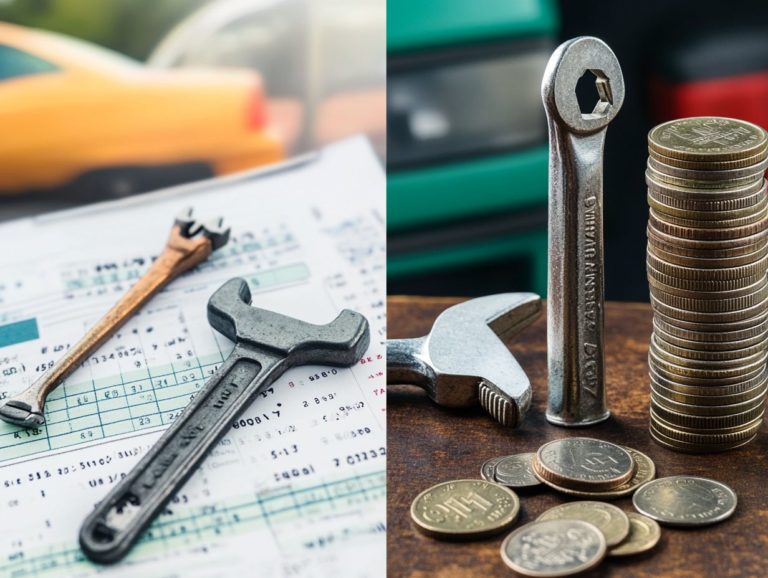Understanding the Trade-In Process for New Cars
Thinking about upgrading your vehicle? Trading in your car might just be the smart, hassle-free option you ve been looking for.
This article will break down what a trade-in actually is, clarifying its definition and the basic process involved. You’ll discover the numerous benefits of trading in your car, from financial advantages to the simplicity of the transaction.
Before you make any decisions, it s crucial to consider key factors that could influence your trade-in experience. You’ll be guided through the step-by-step process, and if trading in doesn t quite suit your needs, there are alternatives to explore.
Dive in and ensure you make the most informed choice possible!
Contents
- Key Takeaways:
- What is a Trade-In?
- Benefits of Trading-In a Car
- Factors to Consider Before Trading In
- The Trade-In Process
- Alternatives to Trading In
- Frequently Asked Questions
- What is the trade-in process for new cars?
- How do I know if my car is eligible for a trade-in?
- Can I negotiate the trade-in value for my car?
- What documents do I need for the trade-in process?
- Can I use my trade-in as a down payment on a new car?
- Is it better to sell my car privately or trade it in at a dealership?
Key Takeaways:

- Trading in your car is using it as payment towards a new car.
- It can save you time and money, as dealerships typically provide better trade-in values and handle the paperwork for you.
- Consider your car’s value, timing, and negotiation strategies to secure the best deal.
What is a Trade-In?
A trade-in involves exchanging your current vehicle at a dealership to receive credit toward the purchase of a new vehicle. This method makes getting into your new car easier and more exciting. You can also get value from your current car, known as trade-in value.
You can find this value using resources like Kelley Blue Book and various online appraisal services. Understanding the trade-in process like managing loan payoffs, dealing with negative equity (when you owe more on your car than it’s worth), and knowing the necessary paperwork is crucial for smart financial decisions.
Definition and Basic Process
The trade-in process begins with evaluating your vehicle registration and its current condition to set a fair trade-in price. This price depends on several factors, such as mileage and maintenance records.
To maximize your trade-in value, thoroughly clean your vehicle, inside and out. A well-presented car can significantly catch the eyes of potential buyers.
Next, gather all relevant documents like the title, service history, and any loan details. This preparation streamlines the process and shows the dealership that you mean business.
When you arrive at the dealership, bring research on comparable vehicle prices. This knowledge allows you to discuss your car’s worth confidently.
Effective negotiation is essential. Presenting yourself confidently can lead to a more favorable financial outcome, potentially securing you an excellent deal when trading in your car.
Benefits of Trading-In a Car
Trading in your car offers several benefits that can greatly influence your financial choices and simplify acquiring a new vehicle. You ll appreciate the convenience of managing multiple transactions at a single dealership, potentially opening up tax advantages.
You can also take advantage of positive equity from your current car, enhancing your trade-in offers and making the entire process feel seamless and rewarding.
Financial and Convenience Benefits
Financial considerations are key reasons for trading in your vehicle. By applying the trade-in value toward new car financing, you can effectively reduce your overall loan amount, leading to lower monthly payments that make budgeting easier.
Improved loan terms often arise from a healthier financial perspective, which the trade-in process can help support. Convenience is another compelling factor; you ll likely appreciate the reduced paperwork and streamlined experience that minimizes your time at dealerships.
This not only simplifies your financial decisions but also enhances your overall satisfaction with the purchasing journey. For prospective car buyers like yourself, trade-in offers present an appealing option worth considering.
Don t miss out on the chance to maximize your trade-in value! Start your trade-in journey today and make your vehicle upgrade a reality!
Factors to Consider Before Trading In
Before you trade in your vehicle, it’s essential to weigh a few key factors that can significantly impact its trade-in value. Consider the condition of your vehicle, its mileage, and the current market trends.
Also, consider if you have negative equity, which happens when you owe more on your loan than the car is worth; this can affect your trade-in value.
Assessing the Value of Your Car
Assessing the value of your car is a crucial step in the trade-in process. You can easily accomplish this using online appraisal tools like Kelley Blue Book. These tools provide an estimated value based on key factors such as your vehicle’s condition and maintenance history.
Carefully checking your vehicle for wear and tear is highly advantageous. It s important to examine both the exterior and interior aspects during this hands-on assessment, as it can uncover critical insights that online tools might overlook.
Additionally, examining your maintenance records helps you understand how well the vehicle has been cared for, which ultimately influences how much people think your car is worth.
By combining these methods, you can arrive at a more accurate estimation that reflects not only your car’s current state but also its potential appeal to future buyers.
Timing and Negotiation Strategies
Timing is crucial in the trade-in process, as market trends significantly influence your vehicle’s value. Being aware of the optimal times to engage with dealers is essential for securing a favorable trade-in price.
Understanding seasonal fluctuations, dealership inventory levels, and consumer demand will help you pinpoint the right moment to make your trade. For example, consider trading in your vehicle during peak purchasing seasons like spring and summer when buyers are actively seeking new models. This can translate into better offers for you.
Equipping yourself with comprehensive knowledge of your vehicle’s condition and leveraging online valuation tools will empower you during negotiations. Employ effective negotiation techniques, such as presenting well-researched data and being prepared to walk away if offers fall short. These strategies can enhance your trade-in offers and ensure a satisfying experience.
The Trade-In Process

The trade-in process unfolds through a carefully structured sequence of steps. It begins with preparing your vehicle for its next chapter, followed by scheduling a comprehensive inspection.
As you gather the necessary paperwork, remember that each document plays a crucial role in this journey. Ultimately, the dealer will evaluate your vehicle, determining its value and leading to the final trade-in price.
Step-by-Step Guide
A step-by-step guide to the trade-in process offers you clarity on the necessary actions. Begin with the following steps:
- Determine your vehicle’s ownership status.
- Collect all the paperwork needed for a seamless transaction.
Understanding whether your vehicle is fully owned or still under a loan is essential, as this will influence the amount of positive equity you can leverage. Next, gather relevant documentation, such as the title, registration, and any outstanding loan statements.
These documents not only establish your ownership but also streamline negotiations at the dealership. It’s imperative that you research your car s current market value to ensure you negotiate the best possible terms during the trade-in.
Make sure to settle any lingering liens on the vehicle ahead of time, as this step can significantly impact the entire process and facilitate a smoother transfer of ownership.
Alternatives to Trading In
While trading in a vehicle may seem like the convenient choice, consider exploring alternatives like a private sale. This approach can often lead to more favorable financial results, especially when market trends indicate that selling outside of a dealership could fetch higher prices.
Explore these options to see which one works best for you and your budget!
Exploring Other Options for Selling Your Car
Exploring alternatives for selling your car, such as private sales or online platforms, allows you to set the selling price based on your vehicle’s features and the current market demand.
Opting for private sales often means you can get a higher price than trade-in offers from dealerships. By cutting out the middleman, this means dealing directly with buyers. This not only gives you control over pricing but also lets you highlight what makes your vehicle special!
Using online platforms is another option that can lead to a quicker sale by providing extensive exposure to potential buyers. These platforms typically offer user-friendly interfaces that make it easy to compare various dealerships’ trade-in options, allowing you to assess whether a private sale or a dealership offer is the better choice.
By leveraging both methods, you can maximize value while ensuring a seamless selling experience.
Frequently Asked Questions

What is the trade-in process for new cars?
The trade-in process for new cars involves giving your current car to a dealership in exchange for credit towards purchasing a new car.
How do I know if my car is eligible for a trade-in?
Most dealerships accept trade-ins if your car is in good shape and has a clean title. However, it’s always best to check with the dealership beforehand.
Can I negotiate the trade-in value for my car?
Yes, you can negotiate the trade-in value for your car, just like you would negotiate the price of a new car. Doing your homework can give you a strong advantage!
What documents do I need for the trade-in process?
You will need to bring your car’s title, registration, and any maintenance records to the dealership for the trade-in process. The dealership may also require a valid driver’s license and proof of insurance.
Can I use my trade-in as a down payment on a new car?
Yes, the trade-in value of your car can be used as a down payment on a new car. This can help lower the overall cost of the new car and potentially lower your monthly payments.
Is it better to sell my car privately or trade it in at a dealership?
It depends on your personal preference and the condition of your car. Selling privately may get you a higher price, but it also requires more time and effort. Trading in at a dealership may be more convenient, but you may not get as much for your car.






